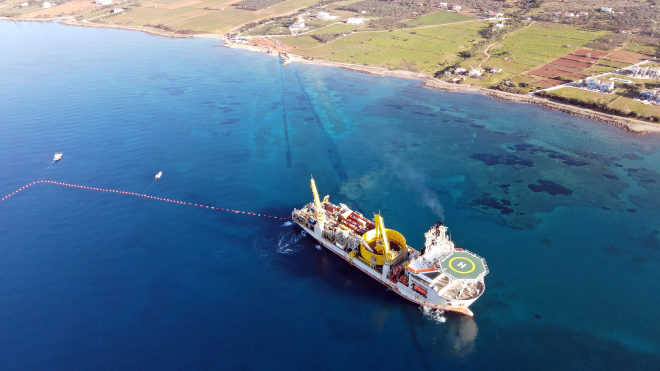Crete-Peloponnese Interconnection

Scope
Turnkey project including the design, supply and installation of a 150kV composite submarine and underground cable system.
Key Facts

Background
Crete is Greece’s biggest and most populous island, as well as a popular tourist destination. The long-standing energy isolation from the mainland and dependence on outdated fossil fuel based generation units had led the island to severe energy security issues, worsening environmental footprint and extremely high cost of power generation. This ambitious project was designed to end Crete’s energy insecurity and unleash the island’s economic potential in a sustainable and environmentally friendly way.
The Crete – Peloponnese circuit 1 (West-Cable) project comprises a one circuit AC of submarine, land power and optical cables system of 178km length for the interconnection of Crete to the Greek mainland (Peloponnese). This project constitutes the first phase of the interconnection of Crete to the Greek mainland grid. The landing points of the submarine cables are in the Kissamos Bay (Crete) and the Malea peninsula (Peloponnese). The land cable section consists of a two-circuit underground section in the Peloponnese (from Peloponnese Sklavouna Terminal Compensation and a single-circuit underground section in the Peloponnese (Megalopolis Municipality, Arcadia Regional Unit).
The record-breaking interconnection between Crete and Peloponnese is one of the most demanding projects ever completed with the longest cable HVAC worldwide (approx. 178 Km) and the deepest one. The laying of the submarine cables was at water depths up to 1,000 m.



Technical information
- Type tested cable mechanical load capacity of 765kN (including factory joint)
- Cable buried into a trench up to a water depth of 1,000m
- Multiple cable protection systems implemented:
- Cast iron shells for locations where cable burial was not possible
- Anti-VIV strakes where potential free spans have been identified
- Bend restrictors with anti-VIV protection at sections where the seabed profile could impose a risk for cable integrity
- Lateral resistor devices to minimize cable rolling and sliding at seabed sections with high lateral slopes
- Mattresses & Protection shells for crossings
R&D&I
During the implementation of the project, Hellenic Cables has embedded significant innovations both in the design of the cable itself as well as for its laying, through advanced and state-of-the-art installation developed especially for this project. Additionally to the record water depth of 1,000m, Hellenic Cables successfully addressed the challenges posed by the highly diversified submarine environment and seabed conditions, comprising of high and steep seabed slopes, sharp rocky outcrops and pockmarks at multiple locations.
In addition, the selection of the most favourable cable route was another great achievement due to the fact that the area is characterised by a very challenging, mostly rocky seabed with very steep longitudinal and side slopes. To increase the reliability of the project, three different types of specifically designed accessories were tested and manufactured in order to protect the cable from free spans, rolling and sliding of the submarine cable and the effects of the seabed’s varying terrain.

Comments of our people involved
“One of the greatest challenges that we faced was designing a cable that was capable of being installed at a depth of 1,000 metres. The design of such a cable requires specialized know-how, which our department possesses. We are very satisfied at Hellenic Cables that the combined efforts of different departments within the company led to the successful testing and certification of our deep-water submarine cable and eventually to the successful installation of the cable for the Crete-Peloponnese interconnection.”
Vasilis Kanas, Offshore Engineering Manager
“We managed to deliver quality work and technology at the highest standard for this record-breaking project ensuring at the same time long-lasting durability”
“The demands for the interconnection project were unprecedented. During the two and a half month period in which we installed the cables, we faced many difficult and important challenges, even on a global scale. We are very proud at Hellenic Cables that we managed to deliver quality work and technology at the highest standard for this record-breaking project ensuring at the same time long-lasting durability.”
Maria Lamprou, Project Manager